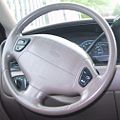1999 Ford Windstar Owner Guide 1st Printing - Page 218
1999 Ford Windstar Manual
Page 218 highlights
Maintenance and care Running out of fuel Avoid running out fuel because this situation may have an adverse affect on powertrain components. If you have run out of fuel: • You may need to crank the engine several times before the system starts to pump fuel from the tank to the engine. • Your "Check Engine" light may come on. For more information on the "Check Engine" light, refer to the Instrumentation chapter. Fuel Filter Your vehicle is equipped with a fuel filter that is mounted on the underbody. For fuel filter replacement, see your dealer or a qualified service technician. Refer to the Scheduled Maintenance Guide for the appropriate intervals for changing the fuel filter. If you replace the fuel filter, replace it with an authorized Motorcraft part. The customer warranty may be void for any damage to the fuel system if an authorized Motorcraft fuel filter is not used. ESSENTIALS OF GOOD FUEL ECONOMY Measuring techniques Your best source of information about actual fuel economy is you, the driver. You must gather information as accurately and consistently as possible. Fuel expense, frequency of fillups or fuel gauge readings are NOT accurate as a measure of fuel economy. We do not recommend taking fuel economy measurements during the first 1 600 km (1 000 miles) of driving (engine break-in period). You will get a more accurate measurement after 3 000 km-5 000 km (2 000 miles-3 000 miles). The advertised fuel capacity of the fuel tank on your vehicle is equal to the rated refill capacity of the fuel tank as listed in the Refill Capacities chart in this "Owner Guide." The advertised capacity is the amount of the Indicated Capacity and the Empty Reserve combined. Indicated Capacity is the difference in the amount of fuel in a full tank and a tank when the fuel gauge indicates empty. Empty Reserve is the small amount of usable fuel remaining in the fuel tank after the fuel gauge indicates empty. 218
















